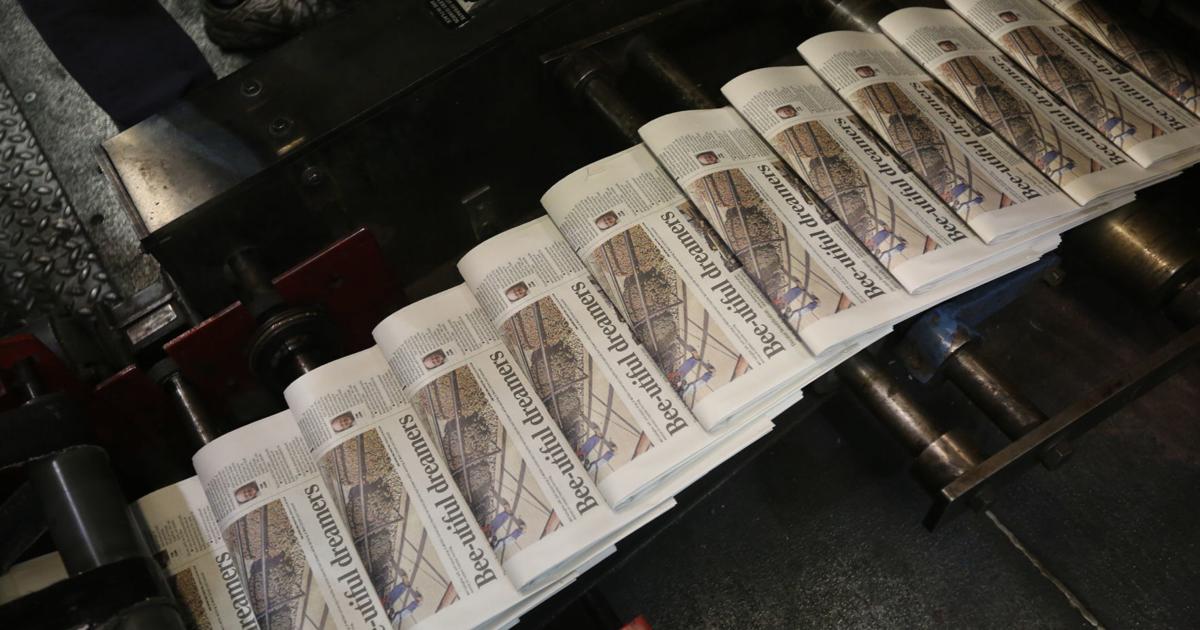- Digital Media Products, Strategy and Innovation by Kevin Anderson
- Posts
- The local journalism crisis and non-commercial models to address it
The local journalism crisis and non-commercial models to address it
37% of Brits are considering cancelling a news or magazine subscription

I was all ready on Friday to do a normal roundup of media developments, and then my wife shared this with me from Bluesky, which from other comments that I have seen is making the rounds on eX-Twitter as well. It shows the decline in newspaper employment in the US from 2010 until now. It’s harrowing.
The newspaper industry, particularly local newspapers, has been in freefall since 2008, the Great Recession. It was buoyed by real estate advertising and the last gasp of the power of local print monopolies. Since 2006, the decline has been devastating, for owners, large media groups, the communities they serve and the people who made their living from the industry - the journalists, photographers, the press operators, the ad sales staff and designers. There are important nuances in the data that tell a fuller story of commercial collapse and societal crisis. However, the decline of newspapers both in the US and the UK has been going on a lot longer than this century. Rasmus Kleis Nielsen of the Reuter’s Institute for the Study of Journalism at Oxford included the following chart in a 2017 paper - Ten Years that Shook the Media World. It shows that the circulation of newspapers in the US has been declining since 1950. Radio and then TV probably had an impact, but the decline of newspaper circulation had been going on for four decades before the Internet was widely available. That being said, an inflection point is visible at roughly 1990, and circulation decline charted a steeper decline than in the decades before.

Paradoxically, you’ll see that revenue took off from 1955 and boomed until 2000. After a brief pause around the time of the dot.com recession, revenue recovered until 2008 when it craters. What happened? As Rasmus and many others have said, the initial decline in US newspaper circulation brought about the first great wave of newspaper consolidation in the US. Initially, this happened at the local level. One of the newspapers I edited for Gannett - the Manitowoc Herald-Times-Reporter was at some point in the past three newspapers, which seems incredible for a town that today has a population of just over 34,000. Local market consolidation gave rise to local print advertising monopolies, particularly in communities not served by a local TV station. From 1970 until 1990, it was a golden age for the newspapers that remained.
The way that the newspaper industry kept the revenue rising after 1990 was to cut costs, and just as the circulation decline began long before the internet, the newspaper employment crisis began before the search, social and mobile disrupted the revenue of newspapers. This is from a MarketWatch story in 2009.

Employment in the US newspaper industry increased even as circulation declined, all the way until the early 90s. That is what is interesting. Employment peaked more than a decade before revenue peaked. More than that, employment began to collapse well before revenue did. Higher revenue in the early 2000s was driven by the beginning of tremendous cuts in employment that only accelerated by the Great Recession. The crisis in local journalism in the US has been decades in the making, and the starting point depends on the metric that you want to focus on. But from an employment standpoint, the sharp decline began late in the 1990s. I initially thought it might have been driven by a decline in advertising spend, but that wasn’t the case (there was a drop in 2001 and 2002 before it recovered). It was most likely driven by the continued decline and search and the beginning of the shift from advertising from print to digital. This famous graph from the Newspaper Association of America with an addition by Thomas Baekdahl shows the decline of newspaper revenue with the rise of Google and Facebook illustrates what happened, although the causal reality is more complicated. And this doesn’t account for the billions of dollars of classified advertising revenue that shifted from newspapers to Craigslist and speciality classified sites.

As Rasmus points out in his 2017 paper, the majority of original reporting has traditionally been done by newspaper reporters. Up until the middle of the last decade, the argument could be made that reporting jobs were shifting to digital, but those jobs weren’t in local journalism. A 2017 analysis by Politico found:
Today, 73 percent of all internet publishing jobs are concentrated in either the Boston-New York-Washington-Richmond corridor or the West Coast crescent that runs from Seattle to San Diego and on to Phoenix. The Chicagoland area, a traditional media center, captures 5 percent of the jobs, with a paltry 22 percent going to the rest of the country.
What does the future look like? Over the next decade (2022-2032), the US Bureau of Labour Statistics forecasts a 17.6% decline in “analysts, reporters, and journalists” at newspaper publishers but also a -14.8 drop in similar roles at radio broadcasters and a -2.4 in roles at TV stations. (A small bright spot is a 5.7% increase at media streamers, social networks and other media outlets.)
And these two stories were already included in my roundup. While ownership, by benevolent billionaires has helped some newspapers and magazines, it hasn’t been a panacea. Many of them are struggling.
What’s the solution to the local journalism crisis?
It is going to require new solutions - commercial, non-profit and public - to address this crisis that has been in the making for decades. In many ways, the crisis in local media mirrors the broader crisis in societies: Wealth and jobs are concentrated in a smaller number of cities, which is driving opportunity and affordability crises in countries around the world. I want to think about solutions for rural communities, where I’m originally from, and towns and smaller cities. Policy has a role to play. In many cases, de-regulation has played a role in consolidation that has left broadcasters and publishers burdened by debt from several rounds of highly leveraged acquisitions. It started before the era of digital disruption and has continued or even accelerated. Smart regulation should focus on policy that ensures that communities have access to local information. And care must be taken, as we saw in Canada when a law intended to support local journalism ended up hurting small, local and independent publishers.
Emily Bell, Director of Columbia’s Tow Center for Digital Journalism, says that independent co-ops are the future of local media.
The future of media is independent, and co-operatively owned. Sign up…see what it’s all about
— emily bell (@emilybell)
11:16 PM • Jan 20, 2024
As I said in the last edition of the newsletter, it is going to take a range of approaches that include co-ops and reader revenue-driven outlets. Co-ops are not a panacea as I saw when I was still living in Ohio and Akron’s Devil Strip news co-op imploded. Ultimately, it suffered from a poor governance structure and lax financial management, which is a bit of an understatement. The Cleveland Scene gave an update and explained that the financial records were so sparse that it made a forensic audit impossible. Ouch. It’s a cautionary tale for local publishers exploring the co-op model
Moreover, reader revenue and co-ops might work in relatively affluent communities larger than 50,000 people, these most likely won’t scale down to smaller communities. Some of those communities are served by strong weeklies, but for many others, there will have to be new solutions.
This is already going on a bit long so I’m going to highlight one: Information Districts. Simon Galperin has been a vocal advocate of the model. He explains that in the US, taxpayer-funded “improvement districts that fund public goods, such as libraries, fire departments, and waste-management services”. The idea would be for a special information district that operate independently of the local government. What is interesting is that in 2020, Simon and Co. found broad, bi-partisan support of the creation of such districts both in individual communities and across rural communities, which needed to pool resources to provide the level of coverage for sparsely populated areas.
The Media Roundup
And now we start the normal media roundup. A survey in the UK found that 37% of Brits were considering cancelling a news or magazine subscription. The biggest reason was the cost-of-living crisis. While this research was done in the middle of last year and there has been inflation relief since then, housing and energy affordability are still major issues.
INMA has an excellent interview with OpenAI looking at AI and news organisations. One thing that caught my eye was new talk of ‘smart agents’. Wow, I remember this idea being floated back in the early part of the 2000s, when techno-utopianism was rife in the early Internet era. And I have to admit to really liking the idea of a smart agent aggregating headlines, but then it would make this newsletter largely redundant.
Nieman Lab looks at how the NYTimes is developing handwriting recognition for its crossword. I think that this is fascinating, especially as study in how major media companies can develop applications using machine learning. However, I also think that this is a data point of how the NYTimes stands alone is many of the things that it is doing.
This is an example of rethinking news products to serve the needs of audiences who may be turning to other sources or other formats. Moreover, I think it requires user research, particularly using the ‘jobs to be done’ framework. More on this in the coming weeks.
Apple has changed how it measures podcast consumption. If you’re like me and haven’t used their app to listen to podcasts recently, then you won’t count as a listener after not listening to five episodes. It has already hit some major podcasts.
The end of third-party cookies is almost upon us, and Digiday has a round-up of ways that publishers are experimenting with responses.
Apple’s AR headset is soon to be released, and TechCrunch’s Brian Heater spent a morning with it.
In other ad developments, Google has laid off hundreds in its ad sales team. Google has already been testing how much they can outsource to AI. As even I have found in my work, this can lead to poor service and opaque issues around even getting Google Ad Manager set up on a site.









